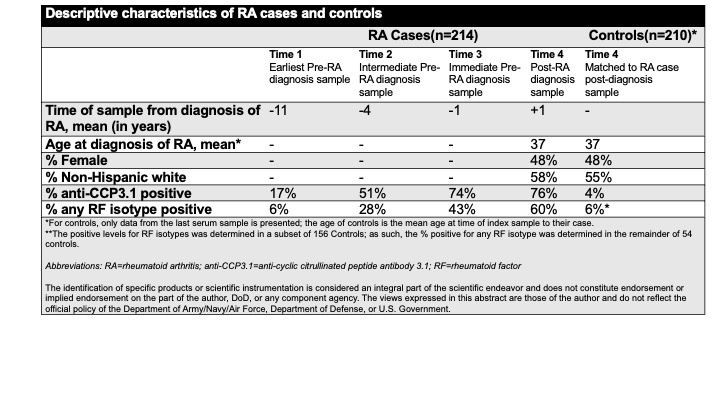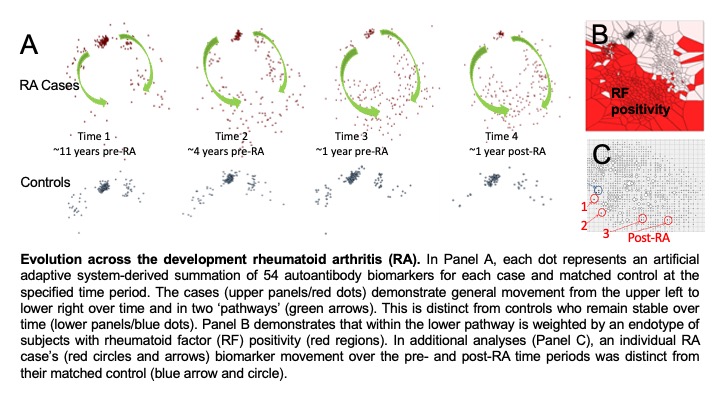Session Information
Session Type: Poster Session D
Session Time: 8:30AM-10:30AM
Background/Purpose: Rheumatoid arthritis (RA) has a ‘pre-RA’ period that can be defined by elevations of antibodies to citrullinated protein antibodies (ACPA), rheumatoid factor (RF), and other measures of inflammation prior to clinically-apparent inflammatory arthritis. Evaluating the evolution of these biomarkers in pre-RA may provide novel understanding of mechanisms of disease development. In addition, advanced analytic techniques may provide unique insights into biomarker evolution. As such, as a proof-of-concept, we evaluated ACPA and RF changes over time in pre-RA using artificial adaptive systems (AAS) in a sample set of pre- and post-RA samples from the Department of Defense Serum Repository.
Methods: We evaluated serial pre- and post-RA diagnosis serum samples obtained from a cohort of 215 individuals with RA (213 with RA classified by 1987 criteria; 2 cases by diagnosis by a board-certified rheumatologist) as well as serial samples from age, gender and race-matched controls. All samples were tested for ACPA using commercial assays for CCP2 (Axis-Shield), CCP3.1 (Inova) and RF-IgA, -IgM and -IgG (Inova). In addition, all samples were tested on a bead-based array containing citrullinated and non-citrullinated antigens. In total, there were 54 biomarkers. We analyzed these biomarkers using AAS and deep artificial neural networks (ANN’s) that characterized biomarker abnormalities within individuals to a single point in time; then, the movement of that point was evaluated over time. Specifically, an Auto Contractive Map (Buscema 2018) was used to project weighted functional links among the biomarkers, an Auto Self Organizing Map (Massini 2021) was then applied to examine how the autoantibodies were clustered at the different temporal steps of the disease evolution, and a multi-dimensional scaling algorithm Population (Massini 2013) was used to understand how each individual summated biomarker profile ‘moves’ over time.
Results: The characteristics of the cases and controls are presented in the Table. At the earliest time point (mean 11 years pre-diagnosis), many RA cases were indistinguishable from controls; however, over time, most RA cases evolved over time to a distinct profile that was present prior to and post-RA diagnosis (Figure, Panel A). In addition, within RA cases, there were two distinct endotypes within cases, with one endotype characterized by RF positivity (Figure, Panel B). Furthermore, within the overall patterns of disease development, an individual RA case’s trajectory could be identified with a clear separation from a control pattern (Figure, Panel C).
Conclusion: Testing for a panel of 54 autoantibodies and application of AAS identified the temporal evolution of RA cases from a state that was initially similar to controls, to a distinct state. Furthermore, within the evolution of RA, there were distinct endotypes of development that included RF-positivity. In addition, an individual’s course could be plotted to estimate their specific time point in the course of disease evolution. Future studies utilizing these analytic approaches with additional biomarkers can be used to identify specific pathways of disease development as well as improve prediction models for future RA.
To cite this abstract in AMA style:
Buscema P, Massini G, Della Torre F, Asadi-Zeydabadi M, O'Donnell C, Newman F, Tagg R, Lodwick W, Collora C, Feser M, Moss L, Robinson W, Thiele G, Mikuls T, Edison J, Holers V, Deane K. Identifying Trajectories and Endotypes in the Evolution of Pre-Rheumatoid Arthritis with Autoantibody Testing and Artificial Adaptive System Analysis [abstract]. Arthritis Rheumatol. 2021; 73 (suppl 9). https://acrabstracts.org/abstract/identifying-trajectories-and-endotypes-in-the-evolution-of-pre-rheumatoid-arthritis-with-autoantibody-testing-and-artificial-adaptive-system-analysis/. Accessed .« Back to ACR Convergence 2021
ACR Meeting Abstracts - https://acrabstracts.org/abstract/identifying-trajectories-and-endotypes-in-the-evolution-of-pre-rheumatoid-arthritis-with-autoantibody-testing-and-artificial-adaptive-system-analysis/


